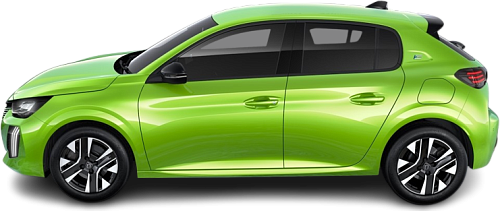USA EV Comparison: Peugeot e-308 Hatchback vs e-208 54 kWh
Struggling to Decide? Let AI Help!
Your AI Summary Is Ready!
General Info
While both vehicles are currently in production, they are not sold in the United States.
The two vehicles share the same body style: Hatchback.
| Property | Peugeot e-308 Hatchback | Peugeot e-208 54 kWh |
|---|---|---|
| Years of Production | 2023-… | 2025-… |
| Current Status | Produced | Produced |
| Country of Manufacture | France | Slovakia |
| Body Style | Hatchback | Hatchback |
| Market Availability | EU | EU |
| GCC Score | 5.4 | 5.3 |
Range and Efficiency
Although both cars have the same battery capacity, Peugeot e-208 54 kWh (2025-...) achieves a longer real-world range due to its superior energy efficiency.
| Property | Peugeot e-308 Hatchback | Peugeot e-208 54 kWh |
|---|---|---|
| Range (WLTP) | 255 mi | 269 mi |
| Range (GCC) | 217 mi | 232 mi |
| Battery Capacity (Nominal) | 54 kWh | 54 kWh |
| Battery Capacity (Usable) | 50.8 kWh | 50.8 kWh |
| Efficiency per 100 mi | 23.4 kWh/100 mi | 21.9 kWh/100 mi |
| Efficiency per kWh | 4.27 mi/kWh | 4.57 mi/kWh |
| Range and Efficiency Score | 7.2 | 7.8 |
Charging
Both vehicles utilize a standard 400-volt architecture.
Both vehicles support DC fast charging with a maximum power of 100 kW.
The Peugeot e-308 Hatchback (2023-…) features a more powerful on-board charger, supporting a maximum AC charging power of 11 kW, whereas the Peugeot e-208 54 kWh (2025-...) is limited to 7.4 kW.
| Property | Peugeot e-308 Hatchback | Peugeot e-208 54 kWh |
|---|---|---|
| Max Charging Power (AC) | 11 kW | 7.4 kW |
| Max Charging Power (DC) | 100 kW | 100 kW |
| Architecture | 400 V | 400 V |
| Charge Port | CCS Type 2 | CCS Type 2 |
| Charging Score | 5.5 | 4.4 |
Performance
Both vehicles are front-wheel drive.
Both cars offer the same motor power, but the Peugeot e-208 54 kWh (2025-...) achieves a faster 0-60 mph time.
| Property | Peugeot e-308 Hatchback | Peugeot e-208 54 kWh |
|---|---|---|
| Drive Type | FWD | FWD |
| Motor Type | PMSM | PMSM |
| Motor Power (kW) | 115 kW | 115 kW |
| Motor Power (hp) | 154 hp | 154 hp |
| Motor Torque | 192 lb-ft | 192 lb-ft |
| 0-60 mph | 9.4 s | 7.9 s |
| Top Speed | 106 mph | 93 mph |
| Performance Score | 3 | 3 |
Dimensions
The Peugeot e-308 Hatchback (2023-…) is longer and wider, but about the same height as the Peugeot e-208 54 kWh (2025-...).
The Peugeot e-308 Hatchback (2023-…) boasts a more extended wheelbase.
| Property | Peugeot e-308 Hatchback | Peugeot e-208 54 kWh |
|---|---|---|
| Length | 171.9 in | 159.6 in |
| Width (with Mirrors) | 81.2 in | 77.2 in |
| Width (w/o Mirrors) | 72.9 in | 69.5 in |
| Height | 56.7 in | 56.3 in |
| Wheelbase | 105.3 in | 100 in |
Cargo and Towing
The Peugeot e-308 Hatchback (2023-…) provides more cargo capacity, featuring both a larger trunk and more space with the rear seats folded.
Neither car is equipped with a frunk (front trunk).
Neither vehicle is officially rated for towing in the US.
| Property | Peugeot e-308 Hatchback | Peugeot e-208 54 kWh |
|---|---|---|
| Number of Seats | 5 | 5 |
| Curb Weight | 3878 lb | 3417 lb |
| Cargo Volume (Trunk) | 14.5 ft3 | 10.9 ft3 |
| Cargo Volume (Max) | 46.7 ft3 | 39.5 ft3 |
| Cargo Volume (Frunk) | - Cargo Volume (Frunk) | - Cargo Volume (Frunk) |
| Towing Capacity | - Towing Capacity | - Towing Capacity |
| Cargo and Towing Score | 3.9 | 3.5 |




